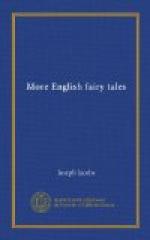LXII. SCRAPEFOOT
Source.—Collected by Mr. Batten from Mrs. H., who heard it from her mother over forty years ago.
Parallels.—It is clearly a variant of Southey’s Three Bears (No. xviii.).
Remarks.—This remarkable variant raises the question whether Southey did anything more than transform Scrapefoot into his naughty old woman, who in her turn has been transformed by popular tradition into the naughty girl Silver-hair. Mr. Nutt ingeniously suggests that Southey heard the story told of an old vixen, and mistook the rustic name of a female fox for the metaphorical application to women of fox-like temper. Mrs. H.’s version to my mind has all the marks of priority. It is throughout an animal tale, the touch at the end of the shaking the paws and the name Scrapefoot are too volkstuemlich to have been conscious variations on Southey’s tale. In introducing the story in his Doctor, the poet laureate did not claim to do more than repeat a popular tale. I think that there can be little doubt that in Mrs. H.’s version we have now recovered this in its original form. If this is so, we may here have one more incident of the great Northern beast epic of bear and fox, on which Prof. Krohn has written an instructive monograph, Baer (Wolf.) und Fuchs (Helsingfors, 1889).
LXIII. THE PEDLAR OF SWAFFHAM
Source.—Diary of Abraham de la Pryme (Surtees Soc.) under date 10th November, 1699, but rewritten by Mr. Nutt, who has retained the few characteristic seventeenth century touches of Pryme’s dull and colourless narration. There is a somewhat fuller account in Blomefield’s History of Norfolk, vi., 211-13, from Twysden’s Reminiscences, ed. Hearne, p. 299, in this there is a double treasure; the first in an iron pot with a Latin inscription, which the pedlar, whose name is John Chapman, does not understand. Inquiring its meaning from a learned friend, he is told—
Under me doth lie
Another much richer
than I.
He accordingly digs deeper and finds another pot of gold.
Parallels.—Blomefield refers to Fungerus, Etymologicum Latino-Graecum, pp. 1110-11, where the same story is told of a peasant of Dort, in Holland, who was similarly directed to go to Kempen Bridge. Prof. E.B. Cowell, who gives the passage from Fungerus in a special paper on the subject in the Journal of Philology, vi., 189-95, points out that the same story occurs in the Masnavi of the Persian port Jalaluddin, whose floruit is 1260 A.D. Here a young spendthrift of Bagdad is warned in a dream to repair to Cairo, with the usual result of being referred back.
Remarks.—The artificial character of the incident is sufficient to prevent its having occurred in reality or to more than one inventive imagination. It must therefore have been brought to Europe from the East and adapted to local conditions at Dort and Swaffham. Prof. Cowell suggests that it was possibly adapted at the latter place to account for the effigy of the pedlar and his dog.




